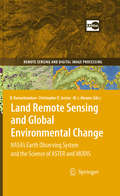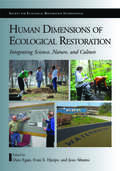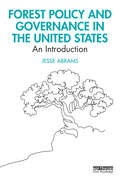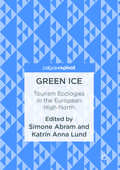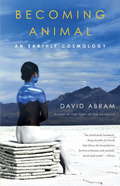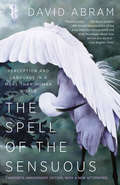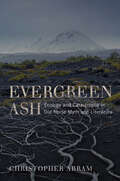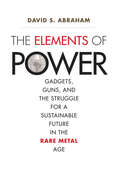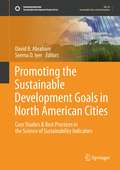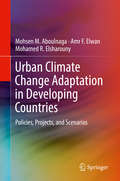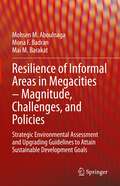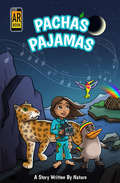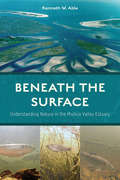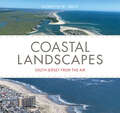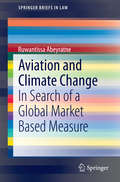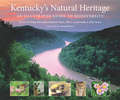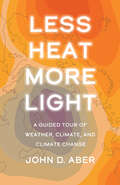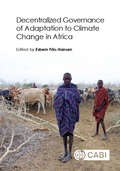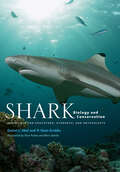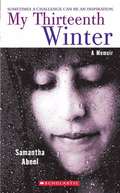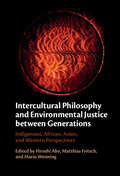- Table View
- List View
Land Remote Sensing and Global Environmental Change
by Michael J. Abrams Christopher O. Justice Bhaskar RamachandranLand Remote Sensing and Global Environmental Change: The Science of ASTER and MODIS is an edited compendium of contributions dealing with ASTER and MODIS satellite sensors aboard NASA's Terra and Aqua platforms launched as part of the Earth Observing System fleet in 1999 and 2002 respectively. This volume is divided into six sections. The first three sections provide insights into the history, philosophy, and evolution of the EOS, ASTER and MODIS instrument designs and calibration mechanisms, and the data systems components used to manage and provide the science data and derived products. The latter three sections exclusively deal with ASTER and MODIS data products and their applications, and the future of these two classes of remotely sensed observations.
Human Dimensions of Ecological Restoration: Integrating Science, Nature, and Culture (Science Practice Ecological Restoration)
by Jesse Abrams Evan E. Hjerpe Dave EganHuman Dimensions of Ecological Restoration takes an interdisciplinary look at the myriad human aspects of ecological restoration. In twenty-six chapters written by experts from around the world, it provides practical and theoretical information, analysis, models, and guidelines for optimizing human involvement in ecological restoration projects. The book delves into the often-neglected aspects of ecological restoration that ultimately make the difference between projects that are successfully executed and maintaned with the support of informed, engaged citizens, and those that are unable to advance past the conceptual stage due to misunderstandings or apathy. The lessons contained will be valuable to restoration veterans and greenhorns alike, scholars and students in a range of fields, and individuals who care about restoring their local lands and waters.
Forest Policy and Governance in the United States: An Introduction
by Jesse AbramsThis new textbook provides an up-to-date and comprehensive introduction to both the policy background and contemporary governance of forests in the United States. Starting with a history of the development of forest policies and conservation agencies, the book then explores the diversity of forest owners, users, and uses and examines emerging approaches to forest governance that cross traditional jurisdictional and property boundaries. It tackles key contemporary issues such as the forest water nexus, the conservation of threatened and endangered species, and the challenges of managing fire, insect, and disease dynamics under a changing climate. Key focal areas include the emergence of collaborative approaches to forest governance, community forest relationships, changes to corporate timberland ownership, and contemporary governance mechanisms such as certification and payments for ecosystem services. This text raises the "big questions" about the distribution of rights and responsibilities in forest management, the tensions between equity and efficiency, and how to sustain a diversity of forest values under the pressures of ecological and social complexity. Written in an accessible and engaging manner, this textbook provides a timely synthesis of both the foundations and current trends and issues in forest policy and governance in the United States with a strong emphasis on illustrative real-world cases. Forest Policy and Governance in the United States is essential reading for students in forest and natural resource policy courses and will be of great use to students in environmental governance courses. It will also be of interest to policymakers and professionals working in forest conservation and in the forest industry.
Green Ice
by Simone Abram Katrín Anna LundThis book presents lively case studies of tourism developments in the European High North from diverse perspectives. It compares views of the changing political ecology of a fragile region shaped by climatic and cultural factors. In exploring the mutual relations between new developments in Arctic travel narratives and tourism practices. Green Ice: Tourism Ecologies in the European High North pays particular attention to the changing discourses that produce, and are in turn produced by, encounters between contemporary Arctic peoples and territories. Questions of gender and nationality are considered alongside a comparison of texts and practices in different languages, examining the politics of language and its significant role in tourism. This title pays attention to the changing symbolic value of Arctic discourses in environmental movements, in order to consider the close connections between global forms of environmentalist discourse and action and local cultural responses. An engaging and timely work, this book will be of great interest to scholars of Geography, Anthropology, and Arctic Tourism.
Becoming Animal
by David AbramDavid Abram's first book, The Spell of the Sensuous--hailed as "revolutionary" by the Los Angeles Times, as "daring and truly original" by Science--has become a classic of environmental literature. Now Abram returns with a startling exploration of our human entanglement with the rest of nature. As the climate veers toward catastrophe, the innumerable losses cascading through the biosphere make vividly evident the need for a metamorphosis in our relation to the living land. For too long we've inured ourselves to the wild intelligence of our muscled flesh, taking our primary truths from technologies that hold the living world at a distance. This book subverts that distance, drawing readers ever deeper into their animal senses in order to explore, from within, the elemental kinship between the body and the breathing Earth. The shapeshifting of ravens, the erotic nature of gravity, the eloquence of thunder, the pleasures of being edible: all have their place in Abram's investigation. He shows that from the awakened perspective of the human animal, awareness (or mind) is not an exclusive possession of our species but a lucid quality of the biosphere itself--a quality in which we, along with the oaks and the spiders, steadily participate. With the audacity of its vision and the luminosity of its prose, Becoming Animal sets a new benchmark for the human appraisal of our place in the whole.From the Hardcover edition.
The Spell of the Sensuous: Perception and Language in a More-than-Human World
by David AbramAnimal tracks, word magic, the speech of stones, the power of letters, and the taste of the wind all figure prominently in this intellectual tour de force that returns us to our senses and to the sensuous terrain that sustains us. This is a major work of ecological philosophy that startles the senses out of habitual ways of perception.
Evergreen Ash: Ecology and Catastrophe in Old Norse Myth and Literature (Under the Sign of Nature)
by Christopher AbramNorse mythology is obsessed with the idea of an onrushing and unstoppable apocalypse: Ragnarok, when the whole of creation will perish in fire, smoke, and darkness and the earth will no longer support the life it once nurtured. Most of the Old Norse texts that preserve the myths of Ragnarok originated in Iceland, a nation whose volcanic activity places it perpetually on the brink of a world-changing environmental catastrophe. As the first full-length ecocritical study of Old Norse myth and literature, Evergreen Ash argues that Ragnarok is primarily a story of ecological collapse that reflects the anxieties of early Icelanders who were trying to make a home in a profoundly strange, marginal, and at times hostile environment.Christopher Abram here contends that Ragnarok offers an uncanny foreshadowing of our current global ecological crisis—the era of the Anthropocene. Ragnarok portends what may happen when a civilization believes that nature can be mastered and treated only as a resource to be exploited for human ends. The enduring power of the Ragnarok myth, and its relevance to life in the era of climate change, lies in its terrifying evocation of a world in which nothing is what it was before, a world that is no longer home to us—and, thus, a world with no future. Climate change may well be our Ragnarok.
The Elements of Power
by David S. AbrahamOur future hinges on a set of elements that few of us have even heard of. In this surprising and revealing book, David S. Abraham unveils what rare metals are and why our electronic gadgets, the most powerful armies, and indeed the fate of our planet depend on them. These metals have become the building blocks of modern society; their properties are now essential for nearly all our electronic, military, and "green" technologies. But their growing use is not without environmental, economic, and geopolitical consequences. Abraham traces these elements' hidden paths from mines to our living rooms, from the remote hills of China to the frozen Gulf of Finland, providing vivid accounts of those who produce, trade, and rely on rare metals. He argues that these materials are increasingly playing a significant role in global affairs, conferring strength to countries and companies that can ensure sustainable supplies. Just as oil, iron, and bronze revolutionized previous eras, so too will these metals. The challenges this book reveals, and the plans it proposes, make it essential reading for our rare metal age.
Promoting the Sustainable Development Goals in North American Cities: Case Studies & Best Practices in the Science of Sustainability Indicators (Sustainable Development Goals Series)
by David B. Abraham Seema D. IyerThis volume presents North American best practices and perspectives on developing, managing and monitoring indicators to track development progress towards the Sustainable Development Goals (SDGs) in local communities and cities. In 4 main sections, the book presents and frames the many ways in which community indicator programs are either integrating or retooling to integrate the SDGs into their existing frameworks, or how they are developing new programs to track and report progress on the SDGs. This is the first volume that focuses on SDG adoption within the context of North Americans cities and communities, and the unique issues and opportunities prevalent in these settings. The chapters are developed by experienced academics and practitioners of community planning and sustainable development, and will add broad perspective on public policy, organizational management, information management and data visualization. This volume presents a case-study approach to chapters, offering lessons that can be used by three main audiences: 1) teachers and researchers in areas of urban, regional, and environmental planning, urban development, and public policy; 2) professional planners, decision-makers, and urban managers; and 3) sustainability activists and interested groups.
Urban Climate Change Adaptation in Developing Countries: Policies, Projects, and Scenarios
by Mohsen M. Aboulnaga Amr F. Elwan Mohamed R. ElsharounyThis book describes the risks, impacts, measures, actions and adaptation policies that have developed globally as a result of the severe impacts of global climate change. In-depth chapters focus on climate change assessment (CCA) in terms of vulnerabilities and reflection on the built environment and measures and actions for infrastructure and urban areas. Adaptation actions specific to developing countries such as Egypt are presented and illustrated. Global Climate change adaptation projects (CCAPs) in developing countries, in terms of their targets and performance, are presented and compared with those existing CCAPs in Egypt to draw learned lessons. Climate change scenarios 2080 using simulations are portrayed and discussed with emphasis on a case-study model from existing social housing projects in hot-arid urban areas in Cairo; in an effort to put forward an assessment and evaluation of current CCA techniques. This book helps researchers realize the global impacts of climate change on the built environment and economic sectors, and enhances their understanding of current climate change measures, actions, policies, projects and scenarios.Reviews and illustrates the impact of global climate change risks;Provides an understanding of global climate change risks in seven continents;Illustrates policies and action plans implemented at the global level and developing countries' level;Discusses climate change assessment and vulnerabilities with emphasis on urban areas;Presents measures and action plans to mitigate climate change scenarios by 2080.
Resilience of Informal Areas in Megacities – Magnitude, Challenges, and Policies: Strategic Environmental Assessment and Upgrading Guidelines to Attain Sustainable Development Goals
by Mohsen M. Aboulnaga Mona F. Badran Mai M. BarakatThis book focuses on the socio-economic and sustainability challenges facing megacities in dealing with the dramatic population increases of informal areas and settlements (or slums), especially when coupled with the impacts and risks of climate change. The authors examine informal urban areas globally and in developing countries utilizing strategic environmental assessment (SEA) as a tool to solve the sequence of upgrading steps concerning slums and shanty towns, and also establish essential guidelines for local governments and stakeholders to create a balance and quality of life for slums dwellers, particularly in the age of the COVID-19 pandemic, through applying sustainability indicators that enhance the upgrading process. Coverage includes recent statistics and mapping of informal areas worldwide and assessment of the GIZ and Sir Norman Foster models in terms of energy demands and consequential emission of CO2 and air pollution from slums. Three models of Maspero’s Triangle are also studied and assessed. The book is essential reading for a wide range of researchers, students, policymakers, governments, and professionals as well as a good source for research centers and academicians working in energy, climate change, urban environments, and sustainable urban development.
The Shell Surprise (Fountas & Pinnell Classroom, Guided Reading)
by Marcie Aboff Laura FreemanNIMAC-sourced textbook. All Kinds of Shells. A boy and his family look for shells at the beach. What they find may surprise you!
Dinosaurs: Over 100 Questions and Answers to Things You Want to Know
by Dan Abnett Nik VincentDid the dinosaurs have armor? Were dinosaurs good parents? Why did the dinosaurs become extinct? Dinosaurs How big were the dinosaurs? Where in the world did the dinosaurs live? You'll find the answers to these and over 100 other intriguing questions inside this beautifully illustrated book.
Pacha's Pajamas: A Story Written by Nature (Morgan James Kids Ser.)
by Aaron Ableman Daveed BenjaminA tale of musical plants, dancing animals, and one little girl’s dream of saving the planet—includes a special augmented-reality feature! Pacha’s imagination is bigger than the Andes Mountains, homeland of her ancestors. In her dreams, the plants and animals on her PJs come alive—and she journeys with them to learn more about herself. Then after a stress-induced asthma attack, her magical pajamas carry her into an epic dream where she encounters a handful of critters lamenting the state of their home. Disguised as a little gorilla, Pacha joins in, and together they decide to organize a Nature Festival that brings all species together. Full of musical plants and dancing animals, the PACHA JAMMA festival is a worldwide call to action to save the planet from destruction. But Mr. Tick seems to be scheming to disrupt the festival. With the help of her plant and animal friends, Pacha races against time to decipher a cryptic puzzle that outlines Mr. Tick’s dastardly plans. But just as she is on the verge of victory, a massive hurricane threatens them all . . . This exciting tale with a message of empowerment and environmental responsibility, including lots of fun science facts and a bonus augmented-reality animation feature, is “a critical tool in giving children a sense of themselves, the power of their dreams and the natural world around them” (Mos Def/Yasiin Bey, actor and recording artist).
Beneath the Surface: Understanding Nature in the Mullica Valley Estuary
by Kenneth W. AbleThe Mullica Valley estuary and its watershed, formed over the last 10,000 years, are among the cleanest estuaries along the east coast of the United States. This 365,000-acre ecosystem benefits from a combination of protected watershed, low human population density, and general lack of extensive development. In Beneath the Surface, marine scientist Ken Able helps the reader penetrate the surface and gain insights into the kinds of habitats, animals, and plants that live there. Readers will gain a better understanding of the importance of these shallow waters; how the amount of salt in the water determines where animals and plants are found in estuaries; the day-night, seasonal, and annual variation in their occurrence; and how change is occurring as the result of climate variation. Throughout the book are insightful sidebars telling intimate stories of where various animals came from and where they are going as they travel through the estuary on their way to and from other portions of the east coast. Beneath the Surface emphasizes the kinds and importance of the animals and plants that live beneath the surface of this unique ecosystem.
Coastal Landscapes: South Jersey from the Air
by Kenneth W. AbleNew Jersey has roughly one hundred and thirty miles of coastline, including a wide array of habitats from marshes to ocean beaches, each hosting a unique ecosystem. Yet these coastal landscapes are quite dynamic, changing rapidly as a result of commercial development, environmental protection movements, and of course climate change. Now more than ever, it is vital to document these landscapes before they disappear. Based on numerous aerial images from helicopter and drone flights between 2015 and 2021, this book provides extensive photographs and maps of the New Jersey coast, from the Pine Barrens to the ocean beaches. The text associated with each exceptional image describes it in detail, including its location, ecological setting, and relative position within the larger landscape. Author Kenneth Able, director of the Rutgers University Marine Field Station for over thirty years, has thoroughly ground-truthed each image by observations made through kayaks, boats, and wading through marshes. Calling upon his decades of expertise, Able paints a compelling portrait of coastal New Jersey’s stunning natural features, resources, history, and possible futures in an era of rising sea levels.
Aviation and Climate Change: In Search of a Global Market Based Measure (SpringerBriefs in Law)
by Ruwantissa AbeyratneThe book addresses the most critical issue faced by aviation and climate change: namely the development of a market based measure to control aircraft engine emissions. It discusses the current market economic trends as they impact to aviation and suggests steps and measures to be taken in the development of a workable MBM. ICAO has three years to come up with such an MBM on a global scale and this book will spur discussions on how to achieve this objective.
Kentucky's Natural Heritage: An Illustrated Guide to Biodiversity
by Greg Abernathy Deborah White Ellis L. Laudermilk Marc Evans“[A] beautiful book about a state that has just about everything except a beach: mountains, swamps, rivers, plains, and, of course, the lovely bluegrass.” —Baton Rouge AdvocateKentucky’s abundance of plant and animal life, from the bottomland swamps in the west to the rich Appalachian forests in the east, is extraordinary as well as beautiful. Glades, prairies, forests, wetlands, rivers, and caves form a biologically diverse patchwork that is unique to the state. Kentucky’s Natural Heritage: An Illustrated Guide to Biodiversity provides an essential reference to the remarkable natural history of the commonwealth and is a rallying call for the conservation of this priceless legacy.Kentucky’s ecosystems teem with diverse native species, some of which are found nowhere else in the world. Kentucky’s Natural Heritage brings these sometimes elusive creatures into close view, from black-throated green warblers to lizard skin liverworts. The aquatic systems of the state are home to rainbow darters, ghost crayfish, salamander mussels, and an impressive array of other species that constitute some of the greatest levels of freshwater diversity on the planet.Richly detailed and lavishly illustrated with more than 250 color photos, maps, and charts, Kentucky’s Natural Heritage is the definitive compendium of the commonwealth’s amazing diversity and presents a persuasive argument for the necessity of conservation. Organized by a team from the Kentucky State Nature Preserves Commission, the book is an outgrowth of the agency’s focus on biodiversity protection.“Between its covers, readers will find details of Kentucky’s vanished natural areas and catalogue of the increasingly rare animal, plants and unique habitats that urgently need protection.” —Louisville Courier Journal
Less Heat, More Light: A Guided Tour of Weather, Climate, and Climate Change
by John D. AberA straightforward and fact-based exploration of how weather happens, how it relates to climate, and how science answers major questions about Earth as a system Climate change is one of the most hotly contested environmental topics of our day. To answer criticisms and synthesize available information, scientists have been driven to devise increasingly complex models of the climate system. This book conveys that the basics of climate and climate change have been known for decades, and that relatively simple descriptions can capture the major features of the climate system and help the general public understand what controls climate and weather, and how both might be changing. Renowned environmental scientist and educator John D. Aber distills what he has learned from a long fascination with weather and climate, the process of science, and the telling of the story of science. This is not a book about policies and politics. Instead, it explores how weather happens, how it relates to climate, and how science has been used to answer major questions about the Earth as a system and inform policies that have reversed environmental degradation. By providing a guided tour of the science of weather, this thoughtful survey will contribute clarity and rationality to the public understanding of climate change.
Decentralized Governance of Adaptation to Climate Change in Africa
by Charles Aben Professor Jacob Agea Bernard Bashaasha Sarah Ann D'Haen Esbern Friis-Hansen Mikkel Funder Carol Mweemba Isaac Nakendo Jonas Østergaard Nielsen Professor Imasiku Nyambe James Okiror Julie Fogt Rasmussen Godfrey SuubiTwo perspectives have dominated the social science discourse on climate change adaptation. Firstly, an international narrative among UN and donor agencies of technical and financial support for planned climate change adaptation. Secondly, a significant volume of studies discuss how local communities can undertake their own autonomous adaptation. Effective and sustainable climate adaptation requires a third focus: understanding of the political processes within sub-national institutions that mediate between national and local practices. This book address the knowledge gap that currently exists about the role of district-level institutions in Sub-Saharan Africa in providing an enabling institutional environment for rural climate change adaptation. Key Features: · Analyses the disconnect between national and local policy and practice, and how to overcome it · Analysis of the political ecology of climate change adaptation in 10 diverse rural districts across Sub-Saharan Africa based on evidence from thorough field work · Explains how to improve the efficiency and effectiveness of climate change adaptation programmes by engaging with decentralized local governments and principles of subsidiarity with regards to decision-making and control over financial resources
Shark Biology and Conservation: Essentials for Educators, Students, and Enthusiasts
by Daniel C. Abel R. Dean GrubbsFeed your fascination with sharks! This complete resource enlightens readers on the biology, ecology, and behavior of sharks with approachable explanations and more than 250 stunning color illustrations.Studies of shark biology have flourished over the last several decades. An explosion of new research methods is leading to a fascinating era of oceanic discovery. Shark Biology and Conservation is an up-to-date, comprehensive overview of the diversity, evolution, ecology, behavior, physiology, anatomy, and conservation of sharks. Written in a style that is detailed but not intimidating by world-renowned shark specialists Dan Abel and Dean Grubbs, it relays numerous stories and insights from their exciting experiences in the field. While explaining scientific concepts in terms that non-specialists and students can understand, Abel and Grubbs reveal secrets that will illuminate even the experts. The text provides readers with a robust and wide range of essential knowledge as it• introduces emerging as well as traditional techniques for classifying sharks, understanding their behavior, and unraveling the mysteries of their evolution;• draws on both established shark science and the latest breakthroughs in the field, from molecular approaches to tracking technologies;• highlights the often-neglected yet fascinating subject of shark physiology, including heart function, sensory biology, digestion, metabolic performance, and reproduction;• addresses big picture ecological questions like "Which habitats do sharks prefer?" and "Where do sharks migrate and for what purpose?";• describes the astonishing diversity of sharks' adaptations to their environment;• discusses which shark conservation techniques do and don't work; and• comments on the use and misuse of science in the study of sharks.Enhanced by hundreds of original color photographs and beautifully detailed line drawings, Shark Biology and Conservation will appeal to anyone who is spellbound by this wondrous, ecologically important, and threatened group, including marine biologists, wildlife educators, students, and shark enthusiasts.
My Thirteenth Winter: A Memoir
by Samantha AbeelSamantha Abeel can't tell time, remember her locker combination, or count out change at a checkout counter and she's in seventh grade. For a straight-A student like Samantha, problems like these make no sense. She dreads school and begins having anxiety attacks. When in her thirteenth winter she's diagnosed with a learning disability, she discovers she's stronger than she ever thought possible. <P><P> <b>Winner of the Schneider Family Book Award</b>
The Sakura Obsession: The Incredible Story of the Plant Hunter Who Saved Japan's Cherry Blossoms
by Naoko AbeThe remarkable 1,200-year history of the Japanese cherry blossom tree--and how it was saved from extinction by an English gardener.Collingwood "Cherry" Ingram first fell in love with the sakura, or cherry tree, when he visited Japan on his honeymoon in 1907. So taken with the plant, he brought back hundreds of cuttings with him to England, where he created a garden of cherry varieties. In 1926, he learned that the Great White Cherry had become extinct in Japan. Six years later, he buried a living cutting from his own collection in a potato and repatriated it via the Trans-Siberian Express. In the years that followed, Ingram sent more than 100 varieties of cherry tree to new homes around the globe, from Auckland to Washington. As much a history of the cherry blossom in Japan as it is the story of one remarkable man, the narrative follows the flower from its adoption as a national symbol in 794, through its use as an emblem of imperialism in the 1930s, to the present-day worldwide obsession with forecasting the exact moment of the trees' flowering.
Intercultural Philosophy and Environmental Justice between Generations: Indigenous, African, Asian, and Western Perspectives
by Hiroshi Abe Matthias Fritsch Mario WenningThis anthology combines an intercultural approach with intergenerational ethics to address critical environmental challenges. Written by scholars from all over the world, including Canada, the US, New Zealand, Nigeria, Ethiopia, Japan, the UK, China, and Spain, this book offers new perspectives on how to foster sustainable societal practises that draw on the past and are fair to future generations. It introduces the Māori idea that views all things and human generations in layered relations; Indigenous accounts of spiralling time and reciprocities among ancestors and descendants; the philosophical dimensions of Chinese conceptions of ancestor spirits and future ghosts; and African accounts of anamnestic solidarity among generations. These ideas influence proposals for how to confront ending worlds and address the environmental future of humanity, making this book a valuable resource for scholars and students of environmental law and policy, environmental humanities, political science, and intercultural and comparative philosophy, as well as policymakers.
How to Survive the Wild (How to Survive)
by Kenny AbdoThis title focuses on the wild and gives information on what it is, how to prepare for it, and how to survive. The title is complete with beautiful and colorful photographs, simple text, and a database for added activities. Aligned to Common Core Standards and correlated to state standards, Bolt! is an imprint of Abdo Zoom, a division of ABDO.
